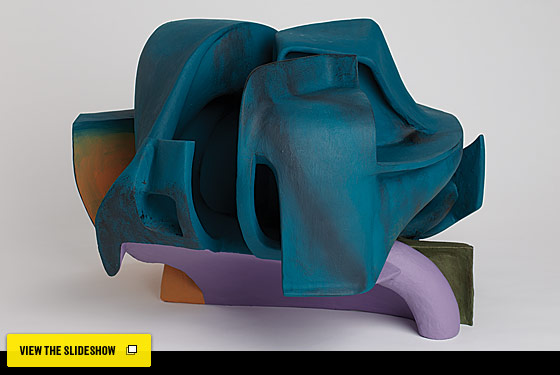 |
Almost everything here comes from an intimate studio experience rather than work made by assistants or jobbed out to China. Many of the best parts of this biennial involve artists wearing multiple hats of many colors, acting as curators, historians, anthropologists, archivists, activists. It lets a thousand hybrids bloom, all without toeing any draconian theoretical line. A walk through the show reveals a forest of good signs. Yet these same signs make me wish the curators had gone even further. Enough of the art that they choose is intentionally underplayed, modest, and provisional so that parts of the show turn twee, genteel, and coy. And like the New Museum’s “Ungovernables” triennial, this show displays a bit of the curatorial tic for an insular in-group of parochial artists whose reflexes are shot. (It’s also sad that, after half the 2010 show’s art was by women, this one is back down to the typical thirtysomething percent.) It’s not a flawless show, by any means—yet I left it with a sense of hope. Art World Babylon is behind us.
The show has been earnestly organized by independent curator Jay Sanders and the Whitney’s Elisabeth Sussman. For those not old enough to remember: Sussman curated the 1993 biennial, the most reviled one in memory. At the time the show was called “grim,” “flimsy,” and “pious.” In fact it turned out to be the most prescient biennial of the last two decades, introducing novel genres of artistic agency and showcasing emergent artists like Matthew Barney, Glenn Ligon, Janine Antoni, Charles Ray, Robert Gober, Charles Atlas, Mike Kelley, and Andrea Fraser. Many notions of integrating form with conceptual art, and unusual materials with the real world, are still being played out all these years later. Indeed, the last four people on the above list are back at the Whitney again this year.
This is a subtle, subdued show, and if you don’t spend significant time looking, especially at the films and videos, you can easily leave with no clear idea of what you’ve seen. (Sanders says, “Our ideal viewer is going to come seven or eight times.”) It’s not for size queens: There are few star turns and no holes blown through walls, gigantic sculptures, or artists waiting in the atrium to stare at you. Most of the art is (pleasingly) sparsely installed, and the large fourth floor has been left almost entirely open for performances. The thrilling sight of this high-ceilinged, wide-open modernist space is a metaphor for the whole show—of artists crawling back into history and form without being smart-alecky body-snatchers or overeducated commentators. It’s a hatchery.
Much of the best work here seems to have been made of stuff found in the real world, altered a bit, then reorganized by extraterrestrials or beavers building a den, basing their work on blind faith. I’ll explain. Michael E. Smith’s odd oatmeal-covered sculptures and Matt Hoyt’s peanut-size primitive implements look as if they’ve been made and arranged by birds; the excellent newcomer Tom Thayer’s reddish room of puppets and crane paintings makes him a modern mythographer by way of William Kentridge and Balinese shadow-plays. Luther Price’s tremendous slides of film he’s manipulated, found, or buried and dug up seem shaped by chance and decay. Vincent Fecteau’s geometric colored shapes look like life-forms from an appliance-based planet presided over by John Chamberlain. In her fabulous video Joanna Malinowska mixes and imbibes a powerful South American psychedelic and shows us her visions of Joseph Beuys. All these artists exude a kind of magic you might pick up around shamans’ huts on the edges of villages. There are even one or two maybe-real shamans-in-residence here: Georgia Sagri marching around her installation like some reincarnated Dada ghost dressed in a T-shirt that makes her look nude, and Dawn Kasper, ensconced in clutter and making art on the spot for the duration of the show. Her messy nest on the third floor is brimming with an odd energy that made me glimpse the mighty spirit of the late sculptural anarchist Jason Rhoades.
Several artists go to higher levels of inner necessity and mad stuff. While the curators were visiting the artist Robert Gober to discuss the show, Gober—who last season curated the exceptional Charles Burchfield exhibition at the Whitney—mentioned that he was working on a project about the little-known mid-century American visionary painter Forrest Bess. The curators gave Gober a room to hang a show-within-a-show where we see ten of Bess’s small, highly colored abstract canvases with symbols signifying, among other things, the time Bess cut a hole into the underside of his penis in search of some alchemical hermaphroditical wholeness. Sarah Michelson ignites massive reservoirs of movement and music by way of Pina Bausch, Merce Cunningham, and Philip Glass in her ambitious fourth-floor performance/dance/mystery play. I couldn’t stop watching Thom Anderson’s 169-minute filmic history of Los Angeles in movies, a West Coast version of Christian Marclay’s masterful The Clock. (And, curators: Where’s The Clock? It’s a defining work of the past two years, and it could’ve been here.)
Finally, there’s Werner Herzog’s ravishing multiscreen projection of the landscapes of the almost totally unknown sixteenth-century artist Hercules Segers, set to a Handel aria. In the catalogue Herzog notes that these Van Gogh–like images are “windows that have been pushed open for us … as if aliens had come upon us in the form of a strange visitation.” That’s what the best art here does. Art is in the process of changing, shedding dead skin, reorganizing some of its structures, and steering its palliative way out of the overheated period we’ve been in. This enticing, flawed manifesto of an exhibition is a peek into this process.
No comments:
Post a Comment